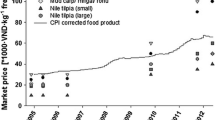Abstract
Mangroves are unique intertidal halophyte formations growing in sheltered tropical and subtropical coastal areas. Due to the increasing population and economic development, mangroves have faced degradation and loss, which has been mainly caused by land conversion into aquaculture ponds in Asia. In the past several decades, the rapid growth of aquaculture has induced water pollution. Using mangroves for effluent treatment from coastal aquaculture ponds could be a suitable approach for wastewater treatment and healthy aquaculture development. An Integrated Mangrove-Aquaculture System (IMAS) was established to test whether the idea of a mangrove in situ treatment for aquaculture wastewater is feasible. The monocultures of three mangroves, Sonneratia caseolaris, Kandelia obovata, and Aegiceras corniculatum were established with area proportions of 45%, 30%, or 15%, respectively. One control pond without mangroves was also set up. The results indicated that the mangroves had different tolerabilities to long-term inundation. The aquaculture ponds had different fishery yields, considering the mangrove species and area proportions. The water quality of most of the experimental ponds was better than the control pond, except for the planted Sonneratia. It is concluded that mangroves can reduce the concentration of dissolved inorganic nitrogen and phosphate, buffer the pH value and increase the concertration of dissolved oxygen in aquaculture water bodies effectively. It is suggested to use 15% of the Aegiceras corniculatum area to conduct in situ purification of aquaculture wastewater and to enhance aquaculture production.
Similar content being viewed by others
References
Cao L, Wang W M, Yang Y, Yang C T, Yuan Z H, Xiong S B, Diana J (2007). Environmental impact of aquaculture and countermeasures to aquaculture pollution in China. Environmental Science and Pollution Research, 14(7): 452–462
Chen G Z, Lan Z H, Peng Y S (2006). National Action Plan of China on Wetlands. Guangzhou: Sun Yat-Sen University Press, 1–10
Fan H Q (2000). Mangrove as a coastal environmental guarder. Nanning: Guangxi Science and Technology Press. 148 (in Chinese)
Food and Agriculture Organization (FAO) (2003). New global mangrove estimate. Available at: http://www.fao.org/forestry/foris/webview/forestry2
Food and Agriculture Organization (FAO) (2007a). The world’s mangroves 1980–2005. Rome: Food and Agriculture Organization. 9–13
Food and Agriculture Organization (FAO) (2007b). The state of world fisheries and aquaculture 2006. Rome: Food and Agriculture Organization, 3–63
Lewis R R (2005). Ecological engineering for successful management and restoration of mangrove forests. Ecological Engineering, 24: 403–418
Li W G, Chen G Z (2005). Decomposition of Mangrove Leaves in Planting-Aquaculture System. In: Chen G Z, Peng Y G, eds. The Integrated Mangrove-Aquaculture System. Guangzhou: Sun Yat-Sen University Press (in Chinese)
Lin P, Fu Q (2000). Environmental Ecology and Economic Utilization of Mangroves in China. Beijing: Berlin Heidelberg CHEP and Springer Verlag
Peng Y G, Chen G Z, She Z M, Yin M (2004) Mangrove and planting-aquaculture ecological coupling system. Acta Scientiarum Natur-alium Universitatis Sunyatseni, 43(6): 150–154 (in Chinese)
Peng Y S, Zhou Y W, Chen G Z (2008). The restoration of mangrove wetland: a review. Acta Ecologica Sinica. 28(2): 786–797 (in Chinese)
Primavera J H (2006). Overcoming the impacts of aquaculture on the coastal zone. Ocean and Coastal Management, 49: 531–545
Robertson A I, Phillips M J (1995). Mangroves as filters of shrimp pond effluent: predictions and biogeochemical research needs. Hydrobiologia, 295: 311–321
Saenger P (2002). Mangrove ecology, silviculture and conservation. Dordrecht: Kluwer Academic Publishers. 1–10
SEPA (State Environmental Protection Administration, People’s Republic of China) (1997). Sea Water Quality Standard (GB 3097–1997) (in Chinese)
Sheue C R, Liu H Y, Yong J W (2003). Kandelia obovata (Rhizophoraceae), a new mangrove species from Eastern Asia. Taxon, 52: 287–294
SOA (State Oceanic Administration, People’s Republic of China) (1998). Criteria of Marine Monitoring and Determination (GB 17378–1998) (in Chinese)
SOA (State Oceanic Administration, People’s Republic of China) (2008). Marine Environmental Quality Bulletin. Available at: http://www.coi.gov.cn/hygb/hjzl (in Chinese)
UNEP (2004). Mangroves in the South China Sea. UNEP/GEF/SCS Technical Publication No. 1. Bangkok: UNEP. 1–12
Ye Y, Tam N F Y, Wong Y S (2003). Growth and physiological responses of two mangrove species (Bruguiera gymnorrhiza and Kandelia candel) to waterlogging. Environmental and Experimental Botany, 49: 209–221
Zheng D Z, Li M, Zheng S F (2003). Headway of study on mangrove recovery and development in China. Guangdong Forestry Science and Technology, 19(1): 10–14 (in Chinese)
Author information
Authors and Affiliations
Corresponding author
Rights and permissions
About this article
Cite this article
Peng, Y., Li, X., Wu, K. et al. Effect of an integrated mangrove-aquaculture system on aquacultural health. Front. Biol. China 4, 579–584 (2009). https://doi.org/10.1007/s11515-009-0056-z
Received:
Accepted:
Published:
Issue Date:
DOI: https://doi.org/10.1007/s11515-009-0056-z




